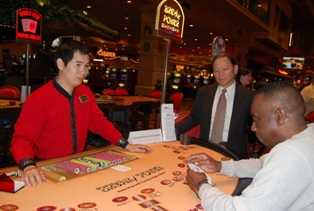On this page
Break Poker
Introduction
Break Poker is a rummy-inspired card game with some similarities to Pai Gow Poker. In the game, players and the dealer each receive seven cards. Of those seven cards, five cards must be selected and separated into a two-card low hand and a three-card high hand. As in Pai Gow Poker, the low hand may not outrank the high hand. The object of the game is to win by having a better combination of hands than the dealer.
Currently, the game can be found at The Orleans in Las Vegas.
Rules
-
The game is played using one standard 52-card deck plus one joker. The joker is a semi-wild card that can be used as an ace or to complete a three of a kind or a straight.
-
Three-card hands are ranked as follows is descending order:
- Three of a Kind. A-A-A is the highest three of a kind and 2-2-2 is the lowest.
- Straight. Q-K-A is the highest straight and A-2-3 is the lowest.
- Pair. A-A-K is the highest pair and 2-2-3 is the lowest.
- High Card Hand. A-K-J is the highest such hand, 5-3-2 is the lowest.
-
Two-card hands are ranked as follows is descending order:
- Pair. A-A is the highest pair and 2-2 is the lowest.
- High Card Hand. A-K is the highest such hand, 3-2 is the lowest.
-
The game uses standard poker rules when comparing individual hands. For example, A-A-2 beats K-K-Q and 3-A beats K-Q.
-
A Lucky Break is a hand consisting of a pair and a three of a kind or a pair and a straight. A Lucky Break beats a non-Lucky Break hand, regardless of the value of the individual two-card and three-card hands.
-
To begin, the player makes a Main Bet. There are also two optional side bets.
-
Each player receives seven cards face down. The dealer receives seven cards face down.
-
Each player examines his cards and selects two cards to play as his low hand, three cards to play as his high hand, and discards the remaining two cards.
-
The dealer reveals his hole cards.
-
The dealer must qualify with at least a K-3-2 in the high hand. If the dealer does not qualify, all Main Bets push1. If the dealer has a qualifying hand, he will set it according to the house way (see below), and compare his hand to each player's hand.
- If the dealer has a Lucky Break and the player does not, the player loses his Main Bet.
- If the player has a Lucky Break and the dealer does not, the player wins and is paid even money on his Main Bet.
- Otherwise, if the player's two-card hand beats the dealer's two-card hand and his three-card hand beats the dealer's three-card hand, the player wins and is paid even money on his Main Bet.
- Otherwise, if the dealer's two-card hand beats or copies the player's two-card hand and the dealer's three-card hand beats or copies the player's three-card hand, the dealer wins and the player loses his Main Bet.
- Otherwise, the player's Main Bet is a push.
Notes
- The concept of eliminating the usual 5% commission with a dealer qualifying rule is claimed by the inventors of both Break Poker and EZ Pai Gow Poker. Without taking a stand on which claim has more legal merit, let it be known it is a patent-protected idea, lest other game inventors illegally steal it.
House Way
The dealer must set his hand according to the following House Way:
- If the dealer can make a hand of Pair & Trips, he does so, putting the highest possible pair for the two-card hand.
- Otherwise, if the dealer can make a hand of Pair & Straight, he does so, putting the highest possible pair for the two-card hand.
- Otherwise, if the dealer can make a hand of No Pair & Trips, he does so, putting the highest possible two cards for the two-card hand.
- Otherwise, if the dealer can make a hand of No Pair & Straight, he does so, putting the highest possible two cards for the two-card hand.
- Otherwise, if the dealer can make a hand of Pair & Pair, he does so, putting the second highest pair for the two-card hand.
- Otherwise, if the dealer can make a hand of No Pair & Pair, he does so, putting the highest possible two cards for the two-card hand.
- Otherwise, the dealer puts the second and third highest cards for the two-card hand.
Main Bet Analysis
Optimal Strategy
The following table shows the probability and return from the various possible outcomes, assuming optimal strategy. The lower right cell shows the house edge of 2.09%.
Main Bet Analysis — Optimal Strategy — Detailed
| Event | Pays | Probability | Return |
|---|---|---|---|
| Player has a Lucky Break, dealer qualifies w/o Lucky Break | 1 | 0.216450 | 0.216450 |
| Player wins both hands | 1 | 0.111850 | 0.111850 |
| Dealer doesn't qualify | 0 | 0.013385 | 0.000000 |
| Player wins two-card hand, copies three-card hand | 0 | 0.004644 | 0.000000 |
| Player wins two-card hand, loses three-card hand | 0 | 0.154003 | 0.000000 |
| Player copies two-card hand, wins three-card hand | 0 | 0.006911 | 0.000000 |
| Player loses two-card hand, wins three-card hand | 0 | 0.143590 | 0.000000 |
| Dealer has a Lucky Break, player does not | -1 | 0.220735 | -0.220735 |
| Player copies both hands | -1 | 0.000380 | -0.000380 |
| Player copies two-card hand, loses three-card hand | -1 | 0.007393 | -0.007393 |
| Player loses two-card hand, copies three-card hand | -1 | 0.004688 | -0.004688 |
| Player loses both hands | -1 | 0.115971 | -0.115971 |
| Total | 1.000000 | -0.020900 |
Next, here is a summarized version of the table above.
Main Bet Analysis — Optimal Strategy — — Summarized
| Event | Pays | Probability | Return |
|---|---|---|---|
| Win | 1 | 0.328300 | 0.328300 |
| Push | 0 | 0.322533 | 0.000000 |
| Loss | -1 | 0.349167 | -0.349167 |
| Total | 1.000000 | -0.020868 |
House Way Strategy
The following table shows the probability and return from the various possible outcomes, assuming the player follows the house way. The lower right cell shows the house edge of 2.48%.
Main Bet Analysis — House Way Strategy — Detailed
| Event | Pays | Probability | Return |
|---|---|---|---|
| Player has a Lucky Break, dealer qualifies w/o Lucky Break | 1 | 0.216354 | 0.216354 |
| Player wins top, wins bottom | 1 | 0.110671 | 0.110671 |
| Dealer not qualified | 0 | 0.013408 | 0.000000 |
| Player wins top, copies bottom | 0 | 0.004763 | 0.000000 |
| Player wins top, loses bottom | 0 | 0.148323 | 0.000000 |
| Player copies top, wins bottom | 0 | 0.007390 | 0.000000 |
| Player loses top, wins bottom | 0 | 0.147264 | 0.000000 |
| Player not Lucky Break, Dealer Lucky Break | -1 | 0.220729 | -0.220729 |
| Player copies top, copies bottom | -1 | 0.000399 | -0.000399 |
| Player copies top, loses bottom | -1 | 0.007559 | -0.007559 |
| Player loses top, copies bottom | -1 | 0.004752 | -0.004752 |
| Player loses top, loses bottom | -1 | 0.118389 | -0.118389 |
| Totals | 1.000000 | -0.024802 |
Next, here is a summarized version of the table above.
Main Bet Analysis — House Way Strategy — Summarized
| Event | Pays | Probability | Return |
|---|---|---|---|
| Win | 1 | 0.327025 | 0.327025 |
| Push | 0 | 0.321148 | 0.000000 |
| Loss | -1 | 0.351827 | -0.351827 |
| Total | 1.000000 | -0.024802 |
Dealer Break Bonus
The Dealer Break Bonus is an optional side bet that pays 1 to 1 if the dealer has a Lucky Break and 4 to 1 if the player also has a Lucky Break.
The following table shows the analysis results. The lower right cell shows a house edge of 5.735%.
Dealer Break Bonus Analysis
| Event | Pays | Probability | Return |
|---|---|---|---|
| Dealer BREAK vs. Player BREAK | 4 | 0.100212 | 0.400848 |
| Dealer BREAK vs. Player non-BREAK | 1 | 0.220795 | 0.220795 |
| Dealer no BREAK | -1 | 0.678993 | -0.678993 |
| Total | 1.000000 | -0.057350 |
Break Bonus
The Break Bonus is an optional side bet that pays based on the player's hand. The following table shows the pay table, the probability of each outcome, and the analysis results. The lower right cell shows a house edge of 7.238%.
Break Bonus Analysis
| Event | Pays | Probability | Return |
|---|---|---|---|
| Five Aces | 200 | 0.000007 | 0.001464 |
| Five of a Kind, 2's to K's | 100 | 0.000088 | 0.008781 |
| Pair with Trips | 6 | 0.041408 | 0.248448 |
| Pair with AKQ | 3 | 0.034206 | 0.102618 |
| Pair with Straight, 32A to KQJ | 1 | 0.245300 | 0.245300 |
| No Lucky Break | -1 | 0.678991 | -0.678991 |
| Total | 1.000000 | -0.072379 |
Acknowledgements
- eTable Games for supplying the math report, by Charles Mousseau, and photo of the game.
- My assistant, Cindy Liu, for help with the write-up.




